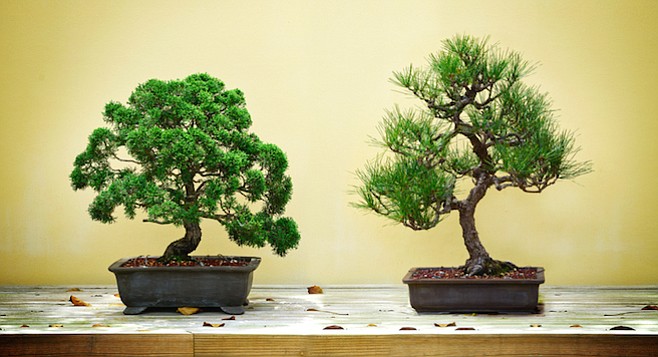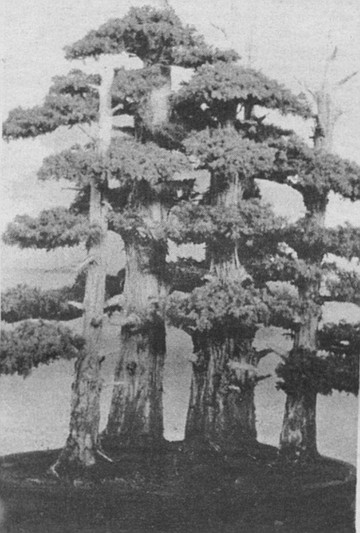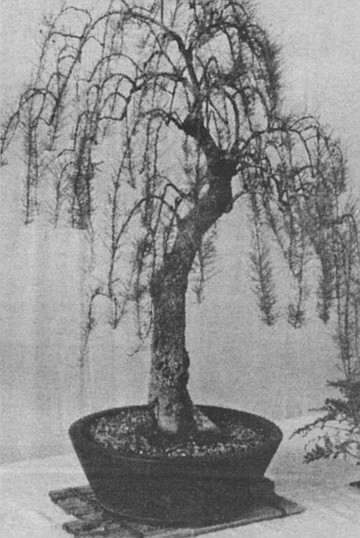 Facebook
Facebook
 X
X
 Instagram
Instagram
 TikTok
TikTok
 Youtube
Youtube

Bonsai and toy dogs. Is it fair to put them in the same category? Is the analogy apt? True, both plant and pet are miniaturized, but look at a toy dog, hear its yap, and before too long, you’ll be agitated. Look at a bonsai, and chances are you’ll soon be relaxed.

It’s irrational, but standing before a small tree growing in a pot, you can feel as tranquil as you would if a miniaturized version of yourself were sitting under it in nature.
John Jackson, who tends an enviable collection of 70 bonsai at his home in Lakeside, says that’s the whole idea. “You get this feeling of contemplation. That’s what we’re trying to project. We want to draw you into the scene, so you can envision yourself in the forest.”

He started out with a general interest in gardening in 1978. Like many a new homeowner, he landscaped his yard. Then, after reading a magazine article about bonsai (pronounced bone-sigh), he decided to take classes.
“It’s much easier if you have a bit of artistic talent,” he says. “Those are the people who seem to do best.” As for himself, “I can’t draw worth a darn, although my brother can, and my father and daughter can.” Rather than crediting any innate ability, he attributes his success to his teacher, whom he calls “one of the best in the world” — John Naka of Los Angeles.

Historically, bonsai were more than ornamental. “Centuries ago, in the time of the Chinese monks, many of the original miniaturized plants were medicinal. In order to carry the plants with them wherever they went, they started cultivating them in pots, so they could have fresh herbs whenever they needed them.” Gradually, the practice evolved into an international art form with a set of basic styles, each conforming to its own aesthetic guidelines that every bonsai grower learns.
Some trees are trained to look windswept, as if they had spent their lives along a windy coast. Others have a cascade of foliage, meant to simulate growth in a mountainous region. Then there are two upright styles. The informal upright has lots of “movement,” as Jackson refers to its many “curves and twists and turns.” The formal upright, which he calls “your basic Christmas-tree style,” has “a real defined branch pattern straight up the tree.”
What style you choose for your bonsai depends on what is best suited to a specimen’s natural design.
Most of the historic trees in Asia were cultivated from seed many generations ago. “They were planted in fields and handed down in a family before they ever became bonsai. But many other, revered trees were collected from nature. They were natural bonsai, hundreds of years old.”
Natural bonsai is not an oxymoron. “A natural bonsai is a tree that has grown in a very rugged environment and is naturally stunted.” Jackson collected some of his in Jacumba. California junipers, they are 500 or 600 years old, but were only 18 or 20 feet tall when he spotted them. “Picking ones that will make good bonsai is where the art comes in. A person has to be able to look at something and see a growth pattern in the lower portion” — which is the only part you take home — “and to imagine that in five, six, or seven years it will be capable of becoming a defined sculpture.”
For the first year and a half, he doesn’t do anything to a newly dug tree, except make sure it stays alive in its container environment. After that come the years of pruning and shaping of branches and roots.
Watering, he says, is easy. “A three- or four-year-old could learn to do it.”
Some people may have been discouraged by experiences with would-be bonsai they bought at a chain store. Jackson isn’t surprised. “Those plants are mass-produced, all potted in the same kind of soil.” In reality, each species has its own requirements. Worse, many people don’t understand that bonsai are meant for outdoors. (Nor are they informed by the brief, accompanying instructions.) So they treat them as houseplants. “I’ll be willing to bet that 85 percent of the chain-store-bought ones are dead within six months,” says Jackson, who thinks it’s a shame, since his practiced eye sees in them “future bonsai” that might well live for years if someone with experience did some styling and took a little more care.
Jackson is one of four people who are giving demonstrations of styling and other techniques at Balboa Park, as part of the San Diego Bonsai Club’s annual show. For best results, club members suggest, consider a bonsai as you would any artwork, say, a painting in a gallery. While illusion is its way, thoughtful repose can be your genuine reward.


Bonsai and toy dogs. Is it fair to put them in the same category? Is the analogy apt? True, both plant and pet are miniaturized, but look at a toy dog, hear its yap, and before too long, you’ll be agitated. Look at a bonsai, and chances are you’ll soon be relaxed.

It’s irrational, but standing before a small tree growing in a pot, you can feel as tranquil as you would if a miniaturized version of yourself were sitting under it in nature.
John Jackson, who tends an enviable collection of 70 bonsai at his home in Lakeside, says that’s the whole idea. “You get this feeling of contemplation. That’s what we’re trying to project. We want to draw you into the scene, so you can envision yourself in the forest.”

He started out with a general interest in gardening in 1978. Like many a new homeowner, he landscaped his yard. Then, after reading a magazine article about bonsai (pronounced bone-sigh), he decided to take classes.
“It’s much easier if you have a bit of artistic talent,” he says. “Those are the people who seem to do best.” As for himself, “I can’t draw worth a darn, although my brother can, and my father and daughter can.” Rather than crediting any innate ability, he attributes his success to his teacher, whom he calls “one of the best in the world” — John Naka of Los Angeles.

Historically, bonsai were more than ornamental. “Centuries ago, in the time of the Chinese monks, many of the original miniaturized plants were medicinal. In order to carry the plants with them wherever they went, they started cultivating them in pots, so they could have fresh herbs whenever they needed them.” Gradually, the practice evolved into an international art form with a set of basic styles, each conforming to its own aesthetic guidelines that every bonsai grower learns.
Some trees are trained to look windswept, as if they had spent their lives along a windy coast. Others have a cascade of foliage, meant to simulate growth in a mountainous region. Then there are two upright styles. The informal upright has lots of “movement,” as Jackson refers to its many “curves and twists and turns.” The formal upright, which he calls “your basic Christmas-tree style,” has “a real defined branch pattern straight up the tree.”
What style you choose for your bonsai depends on what is best suited to a specimen’s natural design.
Most of the historic trees in Asia were cultivated from seed many generations ago. “They were planted in fields and handed down in a family before they ever became bonsai. But many other, revered trees were collected from nature. They were natural bonsai, hundreds of years old.”
Natural bonsai is not an oxymoron. “A natural bonsai is a tree that has grown in a very rugged environment and is naturally stunted.” Jackson collected some of his in Jacumba. California junipers, they are 500 or 600 years old, but were only 18 or 20 feet tall when he spotted them. “Picking ones that will make good bonsai is where the art comes in. A person has to be able to look at something and see a growth pattern in the lower portion” — which is the only part you take home — “and to imagine that in five, six, or seven years it will be capable of becoming a defined sculpture.”
For the first year and a half, he doesn’t do anything to a newly dug tree, except make sure it stays alive in its container environment. After that come the years of pruning and shaping of branches and roots.
Watering, he says, is easy. “A three- or four-year-old could learn to do it.”
Some people may have been discouraged by experiences with would-be bonsai they bought at a chain store. Jackson isn’t surprised. “Those plants are mass-produced, all potted in the same kind of soil.” In reality, each species has its own requirements. Worse, many people don’t understand that bonsai are meant for outdoors. (Nor are they informed by the brief, accompanying instructions.) So they treat them as houseplants. “I’ll be willing to bet that 85 percent of the chain-store-bought ones are dead within six months,” says Jackson, who thinks it’s a shame, since his practiced eye sees in them “future bonsai” that might well live for years if someone with experience did some styling and took a little more care.
Jackson is one of four people who are giving demonstrations of styling and other techniques at Balboa Park, as part of the San Diego Bonsai Club’s annual show. For best results, club members suggest, consider a bonsai as you would any artwork, say, a painting in a gallery. While illusion is its way, thoughtful repose can be your genuine reward.
Comments